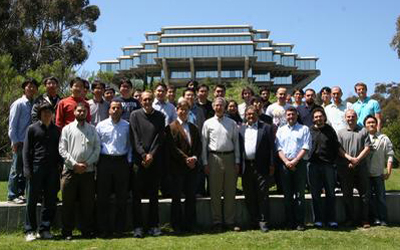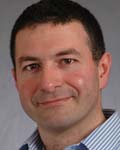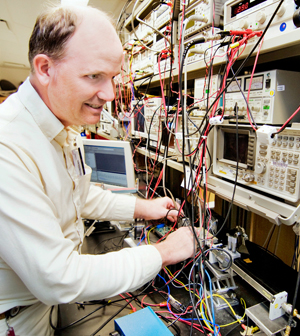The Next Silicon Revolution
San Diego, April 12, 2010 -- Electrical engineers from UC San Diego and the California Institute for Telecommunications and Information Technology (Calit2) are at the leading edge of efforts to merge silicon chip technologies with sophisticated wireless communications tools in the millimeter and microwave range — technologies that traditionally have been too expensive for all but defense and satellite applications.
|
The engineers from the Department of Electrical and Computer Engineering (ECE) who are at the forefront of this latest “silicon revolution” will, for another year, dominate two of the most influential annual academic conferences focused on advanced wireless communications technologies — IMS 2010 and RFIC 2010 — which will run concurrently in Anaheim, CA, May 23-28 (with RFIC running May 23-25). Jacobs School engineers have more accepted papers than any other school at both the IEEE International Microwave Symposium (IMS) and the IEEE Radio Frequency Integrated Circuits Symposium (RFIC) — the premier microwave and RFIC conferences in IEEE, respectively.
|
IMS is the premier annual international meeting for technologists involved in all aspects of microwave theory and practice. The IEEE RFIC Symposium is the top annual conference in the world for reporting recent research developments in Radio Frequency Integrated Circuits (RFICs). RF circuits are responsible for the communications links in all wireless devices.
“The UCSD circuits groups are making microwave and millimeter-wave circuits and systems that are approaching the complexity of a microprocessor and allowing flexibility and functionality for communications that currently is not available,” said electrical engineering professor James Buckwalter.
|
"On-demand video delivered wirelessly is a tidal wave that is sweeping through communications networks on a worldwide basis, and it creates tremendous technical challenges at all layers of the network,” said Lawrence Larson, Professor and Chair, Department of Electrical and Computer Engineering (ECE) at the UC San Diego Jacobs School of Engineering. “In order to accommodate this soaring demand, wireless communications devices will have to operate at higher frequencies and wider bandwidths in order to supply the data.”
The UCSD electrical engineers, who are affiliated with the UCSD Center for Wireless Communications and the UCSD Division of Calit2, are, in fact, working on wireless communications devices that operate at higher frequencies and wider bandwidths than current consumer technologies.
One of the keys to this progress: advances in silicon circuit technologies that enable silicon-based circuits to operate at millimeter and microwave frequencies.
Advanced radio-frequency CMOS chips from the Rebeiz lab, and a silicon-based millimeter wave amplifier that works at 60 to 120 GHz (the Cascaded Constructive Wave Amplifier) from the Buckwalter lab, are just two examples. These kinds of projects are moving toward inexpensive, silicon-based wireless communications links in millimeter and microwave frequency range that can support data transfer rates as fast as 10 Gigabits per second over a kilometer.
“In our labs, we work on advanced radio-frequency CMOS chips, planar antennas, and system-level design so as to result in 10 to 100 times faster data transfers at the same energy consumption. This is done using phased arrays, efficient power amplifiers, very low-noise receivers, and advanced packaging technologies. Systems developed at UCSD have demonstrated data transfer up to 6 Gigabits per second, which is 12 times faster than the best USB protocols,” said Rebeiz.
Engineers in Peter Asbeck’s laboratory are making amplifiers more linear — which can allow packing more bits per hertz (Hz) of bandwidth — and also more power efficient. UCSD projects have shown that both these benefits can be obtained with a combination of advanced microwave design and digital signal processing.
“Our success at IMS and RFIC is a direct result of the investment that UC San Diego has made over many decades in the field of wireless communications. Advanced wireless communications research requires interdisciplinary teams, because it requires innovation in the areas of electronic devices, integrated circuit theory, electromagnetic theory and communications systems. The broad skills of the UCSD faculty have made this extraordinary level of research innovation possible,” said Larson.
The Jacobs School electrical engineering professors presenting work with their students at the conferences are all world-leaders in their fields.
Peter Asbeck leads the High Speed Device Group.
Lawrence Larson leads the Radio Frequency Integrated Circuits Group.
Gabriel Rebeiz leads a Radio-Frequency Micro-Electro-Mechanical (RF MEMS) / Antennas group for Reconfigurable Radios.
Rebeiz and James Buckwalter also lead a microwave/millimeter-wave/THz integrated circuits group for wireless communications and sensors.
Another important contributor is Donald Kimball, a principal development engineer in Calit2, where he runs the High-Power Amplifier Laboratory in the UCSD Division of Calit2.
In addition, the Jacobs School’s ECE Department recently hired Professor Dan Sievenpiper, whose research broadly covers novel electromagnetic structures for antennas and other applications.
With this team of engineers, and their colleagues from ECE, the Jacobs School and Calit2, UCSD is poised to continue to lead in the development of tomorrow’s wireless technologies.
“Visualize the link between the cell phone tower and your smartphone as a straw,” said Larson. “That only lets a limited amount of data through at any one time. In the next few years, we are trying to turn the straw into a fire hose.”
Research funding for the research performed in the UCSD circuits labs comes from a variety of government and corporate sources. DARPA is currently the largest funder. UCSD's Center for Wireless Communications provides financial support and also facilitates critical interactions between UCSD engineers and industry-based researchers.
Media Contacts
Daniel Kane, Jacobs School of Engineering, 858-534-3262, dbkane@ucsd.edu
Related Links
UCSD Center for Wireless Communications (CWC)
Electrical and Computer Engineering (ECE)
Gabriel Rebeiz
Lawrence Larson
Peter Asbeck
James Buckwalter




